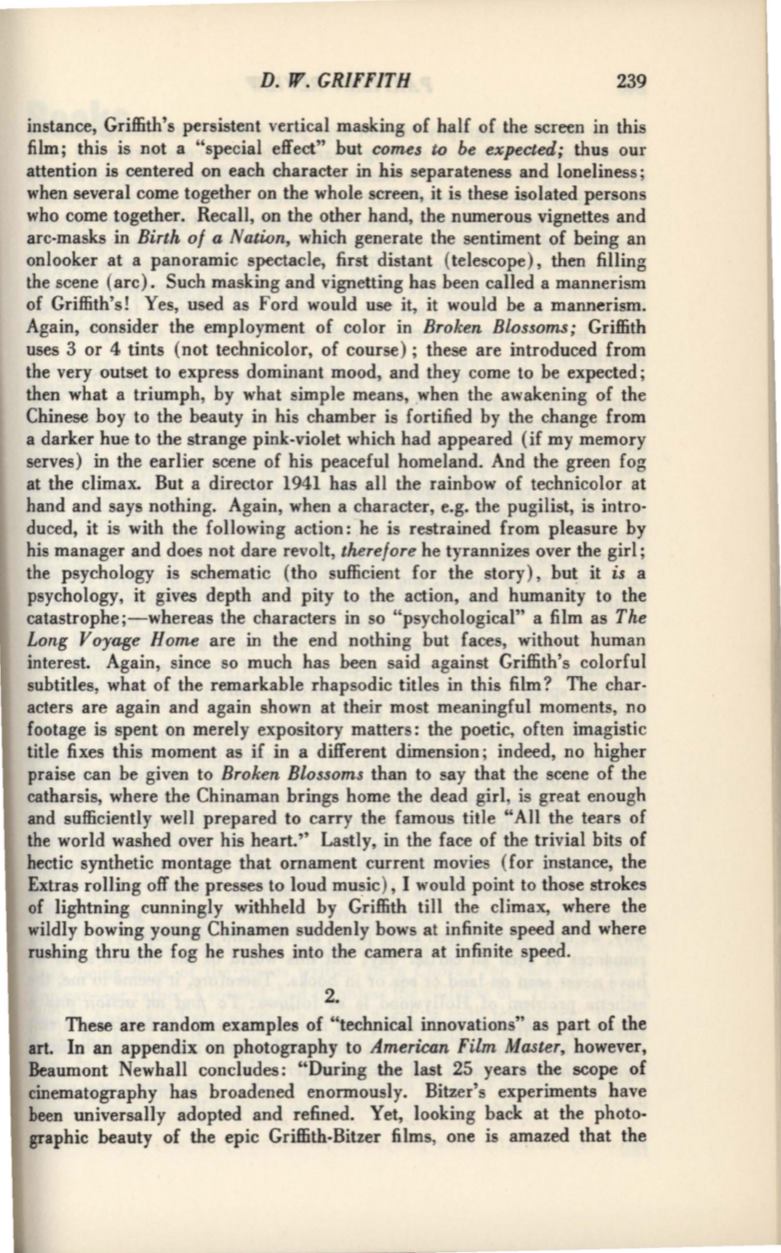
D. W. GRIFFITH
239
instance, Griffith's persistent vertical masking of half of the screen in this
film; this is not a "special effect" but
comes
to
be expected;
thus our
attention is centered on each character in his separateness and loneliness;
when several come together on the whole screen, it is these isolated persons
who come together. Recall, on the other hand, the numerous vignettes and
arc-masks in
Birth of a Nation,
which generate the sentiment of being an
onlooker at a panoramic spectacle, first distant (telescope), then filling
the scene (arc). Such masking and vignetting has been called a mannerism
of Griffith's! Yes, used as Ford would use it, it would be a mannerism.
Again, consider the employment of color in
Broken Blossoms;
Griffith
uses 3 or 4 tints (not technicolor, of course); these are introduced from
the very outset to express dominant mood, and they come to be expected;
then what a triumph, by what simple means, when the awakening of the
Chinese boy to the beauty in his chamber is fortified by the change from
a darker hue to the strange pink-violet which had appeared
(if
my memory
serves) in the earlier scene of his peaceful homeland. And the green fog
at the climax. But a director 1941 has all the rainbow of technicolor at
hand and says nothing. Again, when a character, e.g. the pugilist, is intro·
duced, it is with the following action: he is restrained from pleasure by
his manager and does not dare revolt,
therefore
he tyrannizes over the girl;
the psychology is schematic (tho sufficient for the story), but it
is
a
psychology, it gives depth and pity to the action, and humanity to the
catastrophe ;-whereas the characters in so "psychological" a film as
The
Long Voyage Home
are in the end nothing but faces, without human
interest. Again, since so much has been said against Griffith's colorful
subtitles, what of the remarkable rhapsodic titles in this film? The char–
acters are again and again shown at their most meaningful moments, no
footage is spent on merely expository matters: the poetic, often imagistic
title fixes this moment as if in a different dimension; indeed, no higher
praise can be given to
Broken Blossoms
than to say that the scene of the
catharsis, where the Chinaman brings home the dead girl, is great enough
and sufficiently well prepared to carry the famous title "All the tears of
the world washed over his heart.'' Lastly, in the face of the trivial bits of
hectic synthetic montage that ornament current movies (for instance, the
Extras rolling off the presses to loud
mu~ic),
I would point to those strokes
of lightning cunningly withheld by Griffith till the climax, where the
wildly bowing young Chinamen suddenly bows at infinite speed and where
rushing thru the fog he rushes into the camera at infinite speed.
2.
These are random examples of "technical innovations" as part of the
art. In an appendix on photography to
American Film Master,
however,
Beaumont Newhall concludes: "During the last 25 years the scope of
cinematography has broadened enormously. Bitzer's experiments have
been universally adopted and refined. Yet, looking back at the photo·
graphic beauty of the epic Griffith-Bitzer films, one is amazed that the


